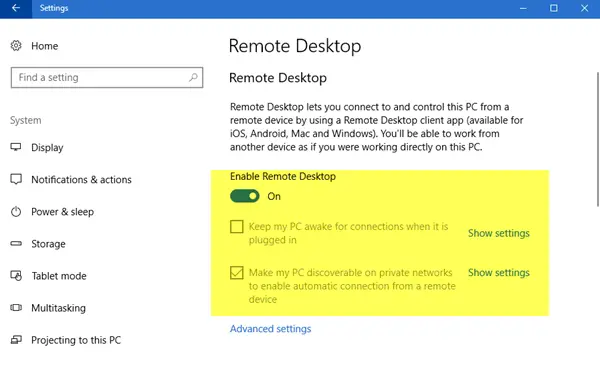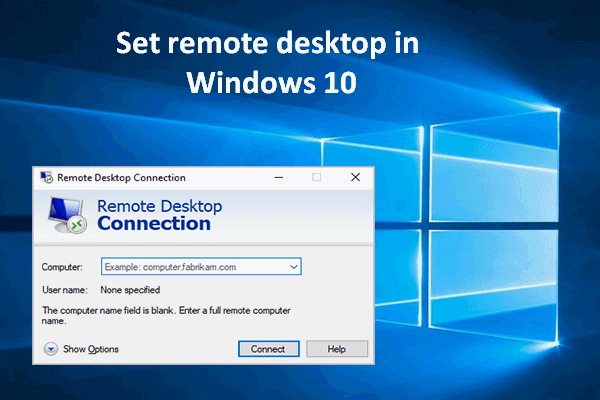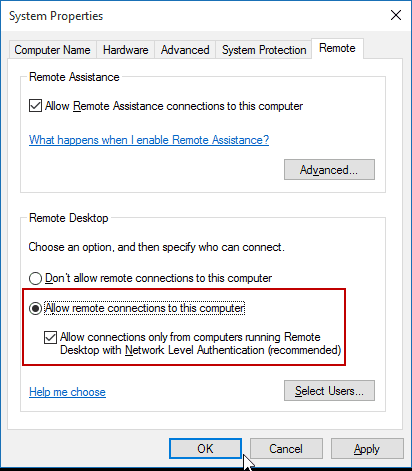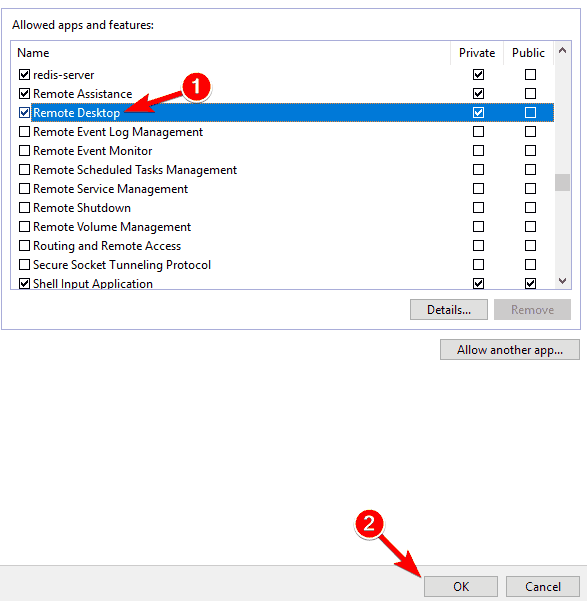Use Remote Desktop on your Windows, Android, or iOS device to connect to a Windows 10 PC from afar. Set up the PC you want to connect to so it allows remote connections: Make sure you have Windows 10 Pro. To check, go to Start Settings System About and look for Edition. To do this, the remote desktop connection must be activated under Windows 10 on the target computer! Please start via the Windows 10 Run window (with the key combination Win-Logo + R) and in the edit box enter the command: mstsc.exe, then open or start the program for Windows -10 remote desktop connection.
- Remote Desktop Protocol For Windows 10
- Remote Desktop Connection Manager Microsoft
- Remote Desktop Protocol Client
Is Your Remote Desktop Enabled. I know, you must have already checked that when you got the. Nov 17, 2020 How to Remove Computer Entries from Remote Desktop Connection History in Windows 10 You can use the Remote Desktop Connection (mstsc.exe) or Microsoft Remote Desktop app to connect to and control your Windows PC from a remote device. Hi, when I connect to a Windows 10 guest using Remote Desktop Protocol, RDP client is Microsoft, I see the remote desktop but it's stuck and after few seconds I got the error: Because of a protocol error, this session will be disconnected. Please try connecting to the remote computer again.
Remote Desktop connection is the default application available in Windows 10 machine to access other windows machines remotely. In Windows 10 there is a issue where once you establish RDP connection to the machine the screen will freeze after some time randomly and you have to disconnect and re-connect the RDP session. To fix RDP connection freezes in Windows 10 you need to disable UDP protocol from RDP client using local Group Policy.
RDP Connection Freezes in Windows 10
RDP uses both UDP and TCP protocols on port 3389. RDP protocol started using UDP from RDP v8 which was released in Windows 8 and Server 2012. The purpose of UDP is to make the connection faster and improve user experience. But in Windows 10, the RDP client freezes the screen randomly. This is most likely because of bug in Windows 10 which is unable to switch between TCP and UDP protocol seamlessly. This issue have been reported in Windows 10 version 1809 to 1903. Disabling the UDP protocol from local group policy fixes this issue.
Step 1. From the Windows 10 machine open Run application.
Step 2. Type gpedit.msc and click OK to open Local Group Policy Editor.

Step 3. Expand Computer Configuration > Administration Templates > Windows Components > Remote Desktop Services > RemoteDesktop Connection Client. Double click the setting “Turn Off UDP On Client”. Choose Enabled option to enable this setting. Click Apply to apply the change.

Now you can open Remote Desktop connection application and start new session. This should fix the freezing issue.
You may also like -
- Install Exchange 2019 in Windows Server 2019 - November 28, 2020
- Why Backup your Microsoft Office 365 - November 27, 2020
- What’s New in VMware vSphere 7 - September 18, 2020
Windows Remote Desktop is one of the go-to proprietary services for those managing a few remote computers on the same network. It’s free, and it’s very easy to set up and use.
But what if you need to support a larger number of clients outside your network? Will WRD be enough for that? Are there any substantial feature limitations?
Let’s dive into the pros and cons of using Windows Remote Desktop and investigate.
Pros
- It’s free. Remote Desktop is a built-in Windows service that runs on the Remote Desktop Protocol and therefore is completely free. You don’t have to spend a single dollar on a third-party tool if your needs are limited to in-office remote support or accessing your centralized file storage on-the-go.
- It’s easy to set up. Although Windows Remote Desktop is disabled in the operating system by default, it’s very easy to turn it on. Note, however, that Home editions of Windows don’t include this service, but we’ll get back to that soon.
Cons
- It may not be that easy to set up outside the office. If you’re planning to use Windows Remote Desktop outside your office network, you’ll need to configure the remote network to accept incoming connection requests. Besides that, you’ll need to know the IP address of the server along with the login credentials for the remote machine(s) you want to connect to. This is a no-go approach if the remote client requiring assistance is not a tech-savvy person.
- It’s only included in Pro, Business or Ultimate versions of Windows. If you need to support your friends, family members, or a large number of clients running any of the Windows Home versions, then Remote Desktop shouldn’t be your tool of choice. You just won’t be able to connect.
- It doesn’t allow to reboot the remote machine and automatically reconnect. Being able to reboot the remote computer and automatically reconnect is a vital remote support feature. While many third-party applications such as FixMe.IT allow you to do that with a single mouse click, Windows Remote Desktop requires additional actions on your end.
- It locks the remote screen, making the remote user unable to interfere or see anything that you’re doing on their machine. This is one of the biggest problems of Windows Remote Desktop that hasn’t been yet resolved. Furthermore, there are no whiteboard tools that would allow you to demonstrate a certain process to your client.
- It doesn’t really allow to run multiple concurrent sessions. Although there’s a workaround that lets you turn on multiple remote desktop connections on Windows 10 & 8, Microsoft’s built-in tool simply wouldn’t be able to handle dozens of connections with different network settings. Techinline’s FixMe.IT, in turn, allows you to run an unlimited number of concurrent support sessions and easily switch between them in the process.
Remote Desktop Protocol For Windows 10


Conclusion
Remote Desktop Connection Manager Microsoft
For local network administration and accessing your office machines remotely, Windows Remote Desktop is a great tool that’s free and easy to set up. However, if your primary goal is to easily perform remote tech support, you’d better check out third-party applications such as FixMe.IT.
Are you using Windows Remote Desktop to access your office machines? Did we miss any of its advantages or disadvantages? Let us know in the comments!
Visit our website to learn more about the FixMe.IT remote desktop application and its features. Join us on Facebook, Twitter, or LinkedIn to get all the latest product and blog updates as they happen.

Remote Desktop Protocol Client
Related Posts
